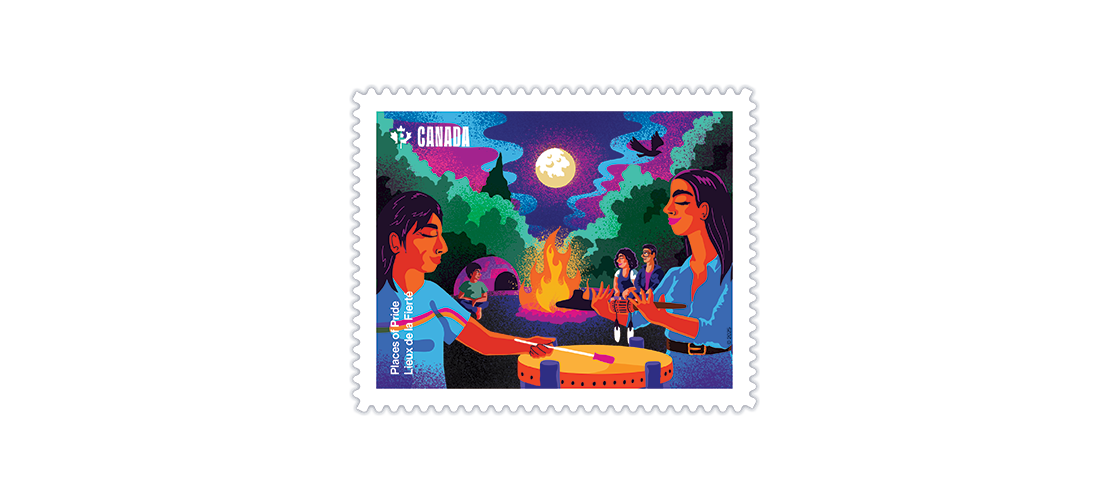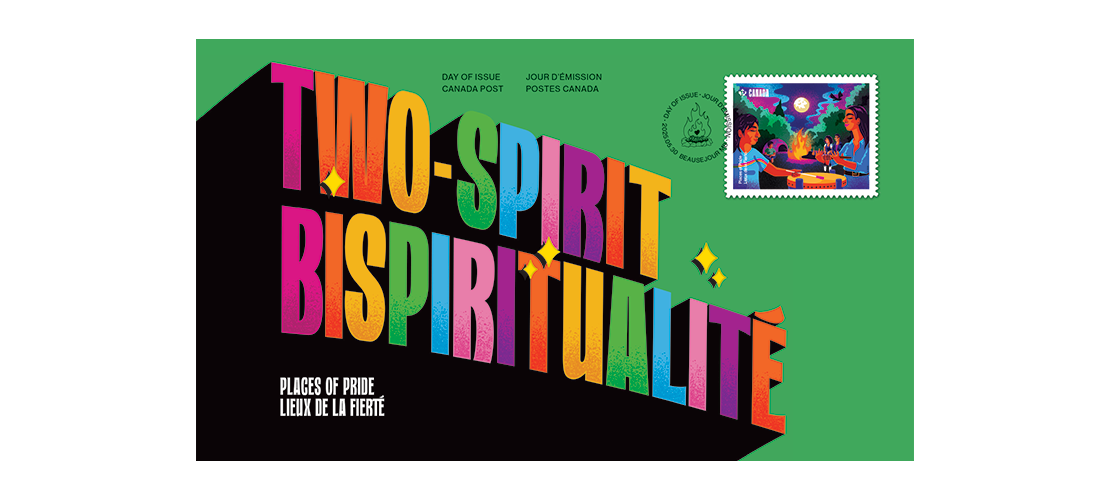In the summer of 1990, Indigenous leaders from across North America assembled just north of Winnipeg, in Beausejour, MB, for the 3rd North American Native American Gay & Lesbian Gathering. The event proved to be a monumental occasion when one of the attendees, Dr. Myra Laramee, introduced the term “Two-Spirit”.
This event and its lasting impact is one of four moments showcased in Canada Post’s latest stamp issue. Issued in time for Pride Month and titled “Places of Pride,” this stamp issue recognizes and honours spaces across the country that Canada’s queer community fought to make their own.
“Two-Spirit” refers to diverse Indigenous understandings of gender, relationships with the spiritual realm, ancestors, and love and support from family and community members. It can describe someone’s sexual, gender and/or spiritual identity.
The introduction of the term and self-naming “was an act of liberation,” Elder Albert McLeod, one of the organizers of the event, tells Canada Post.
“That connection to spirit predates colonialism,” says McLeod, who notes the significant resistance that Western society has shown when it comes to embracing Indigenous values and Indigenous people’s identities.
“That gathering,” he continues, “is when we really broke through that colonial impact, and we made a very powerful connection to our ancestors and the power of our ceremonies, but also to the power of who we are as Two-Spirit people.”

Two years earlier, in 1988, the first Native American Gay & Lesbian Gathering took place in Minneapolis, Minnesota. McLeod and ten others drove down from Winnipeg to take part, and, as he puts it, “became a part of this movement. It was such an engaging and enlightening experience.” They agreed to host the 1990 event and selected the Sandy-Saulteaux Spiritual Centre in Beausejour as the site. At the time, questions surrounding Indigenous identity were thrust to the national forefront during the Kanehsatà:ke Resistance, a 78-day standoff between Kanien’kehá꞉ka (Mohawk), the Quebec police, RCMP and Canadian Army. The crisis was in response to plans to develop a golf course on Kanien’kehá꞉ka land, including a burial ground.
“It was a period when we were searching about our place in our communities, whether we were First Nations, Inuit or Métis,” McLeod explains, “what our histories were about, what our ceremonies and healing was about.” The 3rd North American Native American Gay & Lesbian Gathering provided a powerful setting to do just that.
During the weekend-long event in Beausejour, attendees learned about their spiritual history, including the significance of elements such as the sweat lodge, powwow drums and pipe ceremonies – all of which McLeod notes are meant to bridge connections to the spiritual realm. “That weekend,” he says, “I believe we experienced that connection – to our ancestors, to the power of our ceremonies, but also to the power of who we are as Two-Spirit people.”
The introduction of the name “Two-Spirit” made an immediate impression on those in attendance. Many Indigenous leaders returned home from the gathering and within a matter of months had changed their organizational name from “Gay and Lesbian” to “Two-Spirit,” according to McLeod.
“It took years for the broader queer community to understand what had happened, to understand the name, but also to incorporate it into their work,” says McLeod, who co-founded the Winnipeg-based Nichiwakan Native Gay Society (now 2Spirit Manitoba), one of the first groups for 2SLGBTQIA+ Indigenous Peoples in Canada.
In 2017, then-Prime Minister Justin Trudeau formally apologized for the harms of colonialism on LGBTQ Canadians, marking the first time in Canadian history that the federal government explicitly acknowledged Two-Spirit and Indigenous LGBTQI+ people. Five years later, in 2022, a federal action plan officially saw that “2S” was placed at the front of the 2SLGBTQI+ acronym, further establishing the importance of the term. Today, “Two-Spirit” has become entrenched in queer identity in this country.
Nowadays, the event remains a powerful example of decolonization and queer liberation.
“There’s been a generation of Two-Spirit youth who have grown up without the burden that we carried,” says McLeod. “They’re coming out early. They’re exploring their identities. They’re participating in community. And that really was our objective: to be included. To live full lives as citizens of this nation and as Indigenous peoples. And to not have to explain or apologize for our existence.”

New stamp remembers pivotal moment when “Two-Spirit” term was first introduced and adopted
Available now